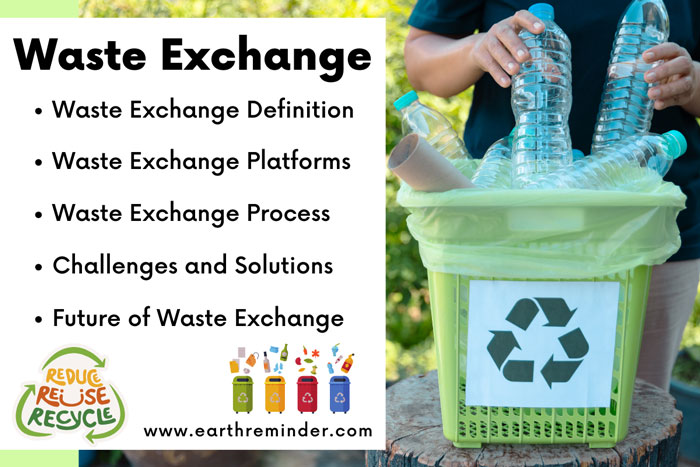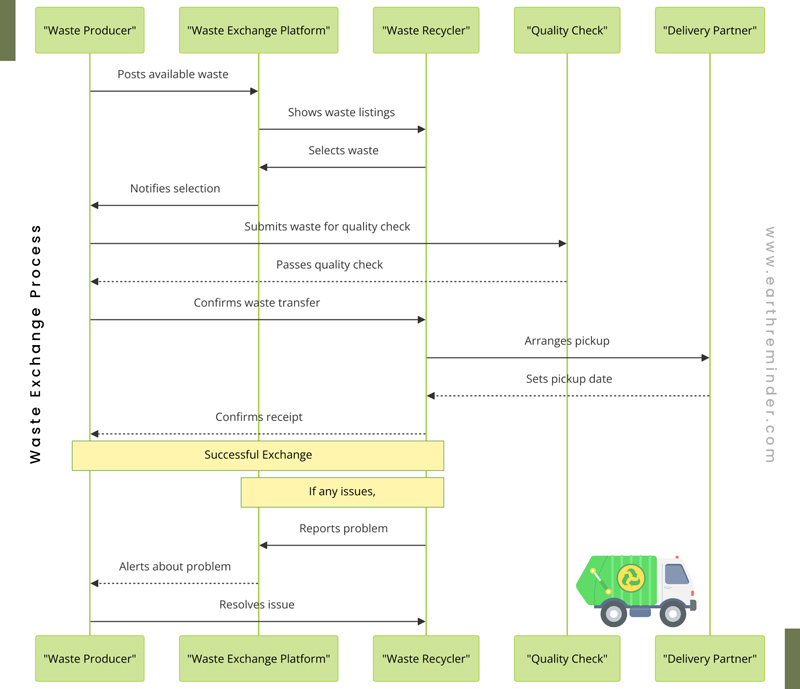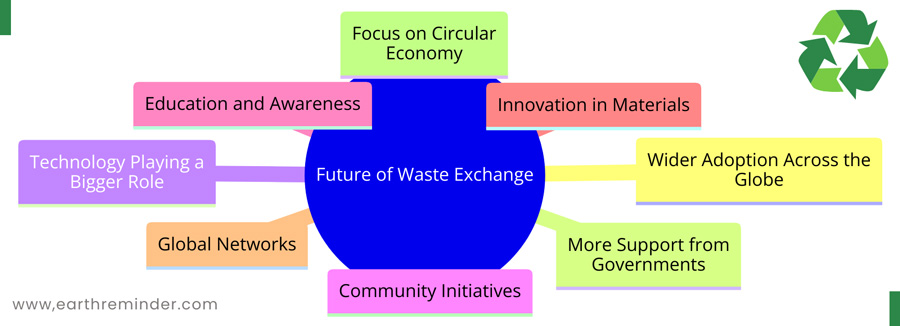Waste Exchange: Platforms, Process, Challenges, and Future
In our world where waste is a growing problem, waste exchange offers hope and sustainability. This innovative approach turns trash into valuable resources, transforming what was discarded into something useful. Waste exchange not only challenges our traditional views on waste management, but also shows how to save resources, reduce landfill use, and encourage a circular economy. Using waste exchange, you can connect people with surplus materials with people who can repurpose them. Here, we will see waste exchange definition, platforms, exchange process, challenges, solutions, and future of waste exchange. So, let’s dive in.
Table of Contents
What Is Waste Exchange?
Waste Exchange Definition: Waste exchange is a way for one person’s or company’s unwanted materials to become another’s resources. It’s about sharing or trading items that are not needed anymore, so they don’t end up as waste. It represents a forward-thinking approach to managing materials that are no longer needed by their original owners.
Waste exchange is great because it’s simple and offers mutual benefits. For the provider, it’s a chance to reduce clutter, decrease waste disposal costs, and help the planet. For the receiver, it gives them access to cheaper or even free materials or goods, which can be really helpful for startups, non-profits, and community projects. In its simplest form, waste exchange is about creating a second life for materials and products.
Waste Exchange Example: Imagine a juice company that ends up with a lot of fruit peels. These peels are waste for the juice company. Now, there’s a farmer who needs natural waste to make compost, which helps plants grow. In this case, the juice company gives the fruit peels to the farmer, who uses them to make organic compost. As a result of this exchange, the juice company gets rid of unwanted waste in an environmentally friendly manner, and the farmer gets free or cheap compost materials. Both sides win.
This process is good for our planet and can also help businesses save money. By reusing materials, we reduce the need for new resources and cut down on pollution. It also means less garbage in landfills.
Waste Exchange Platforms: Types of Waste Exchange Programs
A waste exchange platform is a service, either online or offline, that helps people transfer waste materials from one entity to another, so they can reduce, reuse or recycle them. By allowing businesses, organizations, and sometimes individuals to find, offer, or acquire a wide variety of materials, these platforms hope to reduce waste going to landfills, support environmental sustainability, and promote the circular economy. Various types of waste exchange programs are explained below:
- Online Marketplaces: Websites and apps that allow businesses to list unwanted materials for reuse, reducing waste and helping the environment at the same time.
- Networking Events: Companies can exchange waste materials for reuse at special meetings and gatherings.
- Local Programs: The city or local organizations often run these initiatives where people can drop off or pick up reusable stuff.
- Industry Groups: Through newsletters or meetings, professional associations help members share or trade waste materials.
- Community Bulletin Boards: Individuals can post materials they’re offering or seeking on public boards like community centers.
- Direct Contact: By reaching out to others, companies create opportunities for material reuse.
- Waste Brokers: A specialist who facilitates the exchange of waste materials between companies with waste materials and those who need them.
Below, we will understand deeply waste exchange process that will include the waste exchange platform.
Waste Exchange Process
In most cases, the process begins with listing the unwanted materials on a platform or network. Then, someone who needs those materials can claim them. Materials are then exchanged or transferred between the two parties.
Here’s a breakdown of each step in the diagram:
- Waste Producer Posts Available Waste: On a waste exchange platform, waste producers post details about the waste materials they have.
- Waste Exchange Platform Shows Waste Listings: These waste listings are then shown to potential recyclers, making it easy for them to find waste they can recycle.
- Waste Recycler Selects Waste: When a waste recycler finds waste materials that meet their requirements, they select them on the platform.
- Platform Notifies Producer of Selection: Waste exchange platforms notify waste producers when a recycler selects their waste.
- Producer Submits Waste for Quality Check: To ensure the waste meets certain standards, the producer submits it for a quality check before transferring it.
- Quality Check Passed: When the waste passes the quality standards, the quality check entity notifies the producer.
- Producer Confirms Waste Transfer: Upon passing the quality check, the waste producer transfers the waste to the recycler.
- Recycler Arranges Pickup with Delivery Partner: To arrange the pickup of the selected waste materials, the recycler coordinates with a delivery partner (logistics company).
- Delivery Partner Sets Pickup Date: It’s the delivery partner’s job to confirm the pickup date with the recycler, so everything runs smoothly.
- Recycler Confirms Receipt of Waste: The recycler confirms receipt of the waste materials to the waste producer, marking the completion of the exchange.
- Successful Exchange: Upon completing the exchange, a note will be left on the producer’s and recycler’s desk, indicating that the exchange has been successful.
- Handling Issues: If any issues arise, like quality issues, the above diagram illustrates a feedback loop that includes:
- The recycler reports the problem to the exchange platform.
- The platform alerts the producer about the problem.
- Producers and recyclers work together to resolve the issue, ensuring a smooth waste exchange.
In the above diagram, we have simplified the waste exchange process, so it’s easy to understand for anyone not familiar with waste management or recycling. Identifying the steps and interactions between waste producers, recyclers, and other parties involved highlights the collaborative effort required for waste recycling.
You can join online waste exchange platforms, participate in local community programs, or start your own waste exchange initiative in your workplace. The idea behind it is to be open to utilizing or offering materials that would otherwise be thrown away.
Challenges and Solutions of Waste Exchange
Despite being promising, waste exchange faces several challenges that can hinder its effectiveness. Finding the right match for waste materials is one of the biggest challenges. By developing online platforms with advanced algorithms and filtering options, it will be easier to match waste materials with users. Here are some major challenges and possible solutions:
Finding the Right Match
- Problem: When you throw something away, it’s not always easy to find someone who needs it.
- Solution: Using websites, we can match people’s waste with those who need it. In these websites, people have the option to list what they need and what they have, making it easier for people to find the right product.
Moving Stuff Around
- Problem: Once you find a match, moving the waste can be difficult, especially if it’s heavy or big.
- Solution: It would be great to have local spots where people can drop off their waste. In this way, others can easily pick it up. It may also be a wise idea to team up with delivery companies to make the process easier and more efficient.
Rules and Help from the Government
- Problem: The lack of help or rules can sometimes make waste exchange difficult.
- Solution: The government can help by making it easier for people to do waste exchange. They may provide rewards or cover some of the costs.
Teaching People
- Problem: The process of waste exchange and its benefits are not well understood by everyone.
- Solution: Our schools can teach people more about it. It may be helpful to share success stories about how it has helped or what can be done in order to encourage more people to try it.
Using Technology
- Problem: It can be difficult to keep track of everything and to ensure that waste is taken to the right place.
- Solution: New technology, like apps or websites, can help keep everything organized. If you need something, they can tell you who has it nearby, or they can assist you with tracking your waste until it finds a new home.
In short, waste exchange has its challenges, but we can overcome them with smart ideas and teamwork. The goal is to find simple ways to connect people with each other so they can move things more easily.
Also Read: Waste Management and Its Importance.
Future of Waste Exchange
As we look forward, the future of waste exchange is not just bright; it’s transformative. Waste exchange plays a key role in the development of a circular economy and sustainability. Here’s what we can expect:
Wider Adoption Across the Globe
Waste exchange will become more popular as awareness grows. This means not just big cities but also smaller towns and rural areas getting involved. Everyone can join in, no matter where they are right now.
More Support from Governments
Eventually, governments will see how waste exchange cuts landfill waste and saves natural resources. There might be more policies and programs to encourage waste exchange, like funding for local exchange centers or tax benefits.
Technology Playing a Bigger Role
Waste exchange will be easier and more efficient with technology. Apps might match waste producers with recyclers or users instantly. Innovations in tracking and logistics could also help solve the transportation challenge, making the exchange process faster and smoother.
Community Initiatives
Local waste exchange programs will become more common, and communities will get more involved. The programs can be tailored to meet a community’s specific needs, whether it’s exchanging household items, garden waste, or construction materials. Getting the community involved won’t just help reduce waste, but also strengthen local connections.
Education and Awareness
Schools and organizations will teach about waste exchange and how to reduce waste and reuse materials. More people will participate when they understand the benefits.
Also Read: What Is the Difference Between Reuse and Recycle?
Innovation In Materials
In the future, materials might also be designed and used differently, making them easier to recycle. In this way, waste exchange would be even more effective, since materials could have a planned second life from the beginning.
Global Networks
There could be global waste exchange networks, where materials can be shared across borders. Materials that are rare or valuable would be particularly useful for this purpose.
Focus on Circular Economy
Ultimately, waste exchange will be a key part of a circular and sustainable economy, where waste is eliminated entirely and resources are kept in use for as long as possible. By changing our thinking about production, consumption, and waste, we’ll be able to adopt more sustainable practices.
Conclusion
Waste exchange is a simple idea with big benefits. It’s about giving away what we don’t need to someone who does. In this way, a significant amount of trash is reduced and resources are saved. Taking part in waste exchange programs can be a great way for us all to help the planet. This is something everyone can do to make a difference. Together, let’s make our world cleaner and greener by converting waste into something valuable.


